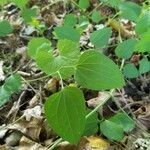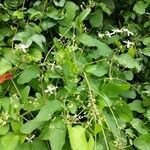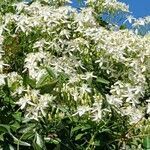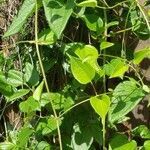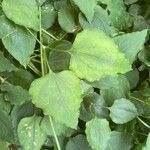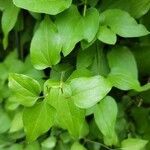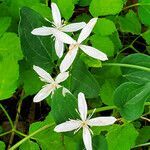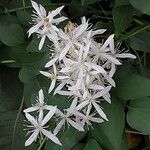Stems climbing with tendril-like petioles and leaf rachises, 3-6 m. Leaf blade pinnately 3-or 5-foliolate; leaflets ovate or broadly lanceolate to narrowly deltate, to 6.5 × 3.5 cm, margins entire; surfaces abaxially glabrous or very sparingly appressed-strigose on major veins. Inflorescences axillary, 3-12-flowered cymes or compound cymes or paniculate with cymose subunits. Flowers bisexual, often some unisexual (staminate) in same inflorescence; pedicel 1-3.5 cm, slender; sepals wide-spreading, not recurved, white, linear or elliptic to lanceolate or narrowly obovate, 0.9-2.2 cm, length ca. 2-3 times width, abaxially tomentose along margins, adaxially glabrous; stamens ca. 50; filaments glabrous; staminodes absent; pistils 5-10. Achenes broad, flat, conspicuously rimmed, minutely appressed-silky, sometimes sparsely so; beak 2-6 cm.
Stem climbing, 2–3 m; herbage glabrous; lfls mostly 5, ± coriaceous, triangular-ovate to broadly ovate, obtuse to acuminate, entire or rarely with an entire lobe, rounded to cordate at the base, the terminal one long-stalked; fls numerous, white, 2–3 cm wide; sep densely pubescent along the margins and on the back; achenes glabrous or minutely appressed-hairy, 8 mm; mature style plumose, 2–3 cm; 2n=16, 48, 64. Native of Japan, commonly cult. and often escaped. July–Sept. (C. dioscoreifolia; C. maximowicziana; C. paniculata Thunb., not J. F. Gmel.)
A scrambling woody vine. It keeps growing from year to year. The leaves have leaflets along the stalk. There are 3-5 leaflets. They are 10 cm long and deep green.
